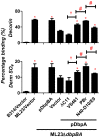Strain-specific variation of the decorin-binding adhesin DbpA influences the tissue tropism of the lyme disease spirochete
- PMID: 25079227
- PMCID: PMC4117581
- DOI: 10.1371/journal.ppat.1004238
Strain-specific variation of the decorin-binding adhesin DbpA influences the tissue tropism of the lyme disease spirochete
Abstract
Lyme disease spirochetes demonstrate strain- and species-specific differences in tissue tropism. For example, the three major Lyme disease spirochete species, Borrelia burgdorferi sensu stricto, B. garinii, and B. afzelii, are each most commonly associated with overlapping but distinct spectra of clinical manifestations. Borrelia burgdorferi sensu stricto, the most common Lyme spirochete in the U.S., is closely associated with arthritis. The attachment of microbial pathogens to cells or to the extracellular matrix of target tissues may promote colonization and disease, and the Lyme disease spirochete encodes several surface proteins, including the decorin- and dermatan sulfate-binding adhesin DbpA, which vary among strains and have been postulated to contribute to strain-specific differences in tissue tropism. DbpA variants differ in their ability to bind to its host ligands and to cultured mammalian cells. To directly test whether variation in dbpA influences tissue tropism, we analyzed murine infection by isogenic B. burgdorferi strains that encode different dbpA alleles. Compared to dbpA alleles of B. afzelii strain VS461 or B. burgdorferi strain N40-D10/E9, dbpA of B. garinii strain PBr conferred the greatest decorin- and dermatan sulfate-binding activity, promoted the greatest colonization at the inoculation site and heart, and caused the most severe carditis. The dbpA of strain N40-D10/E9 conferred the weakest decorin- and GAG-binding activity, but the most robust joint colonization and was the only dbpA allele capable of conferring significant joint disease. Thus, dbpA mediates colonization and disease by the Lyme disease spirochete in an allele-dependent manner and may contribute to the etiology of distinct clinical manifestations associated with different Lyme disease strains. This study provides important support for the long-postulated model that strain-specific variations of Borrelia surface proteins influence tissue tropism.
Conflict of interest statement
The authors have declared that no competing interests exist.
Figures





References
-
- Steere AC (2001) Lyme disease. N Engl J Med 345: 115–125. - PubMed
Publication types
MeSH terms
Substances
Grants and funding
LinkOut - more resources
Full Text Sources
Other Literature Sources
Medical
Miscellaneous

